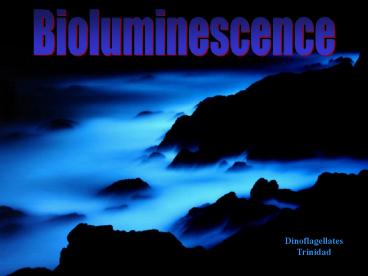Bioluminescence - PowerPoint PPT Presentation
1 / 46
Title:
Bioluminescence
Description:
Title: PowerPoint Presentation Author: Michelle Miliefsky Last modified by: Michelle Smith Created Date: 5/21/2002 12:56:29 AM Document presentation format – PowerPoint PPT presentation
Number of Views:1757
Avg rating:3.0/5.0
Title: Bioluminescence
1
Bioluminescence
Dinoflagellates Trinidad
2
What are the conditions like in the deep sea?
Physical Biological What are food sources
for animals that live in the deep sea?
3
Ocean Zones
0 m
photic
200 m
dysphotic
1000 m
2000 m
aphotic
4000 m
6000 m
4
Light Penetration in the Ocean
50 m
100m
Depth in meters
150 m
200 m
5
Ocean Zones
0 m
photic
200 m
dysphotic
1000 m
2000 m
What color of light will animals use?
aphotic
4000 m
6000 m
6
Light
- Types of light production
- incandescence light bulb
- luminescence- fluorescence bulb
- What is the difference between these types of
light? - Bioluminescence a chemical reaction
7
Give examples of organisms that are
bioluminescent?
8
Evolution of Bioluminescence
- O2 is toxic to some bacteria
- Convert O2 to a nontoxic substance
- Light is a byproduct
- Benefit to some organisms
Fossilized bacteria 3.5 bya
9
Bioluminescence Chemical Reaction
luciferase Luciferin O2
oxyluciferin light
Bioluminescence Not found in freshwater
organisms.
10
Types of Bioluminescence
- Bacterial
- Intrinsic
Photobacterium
11
Bacteria
- Photobacterium (symbiotic relationship)
- Achromabacteria (2 types of squid use bacteria,
the rest (17) make their own) - Beneckea (not associated with symbiotic
relationship)
Vibrio fischeri
12
Photophore
(bacterial)
Light emitting organ
13
- How do they get bacteria?
- organ open to exterior
- potentially continuous luminescence
14
Bacterial Symbiont
Tunicate- Pyrosoma- bacterial symbiont
(intracellular)
15
Bacterial photophores
Squid Euprymna- squid hatches w/out bacteria
w/in hours it is infected w/natural populations
of bacteria
16
Bacterial Photophores in Fish
flashlightfish
Pinecone fish
Anglerfish
Ichthyococcus
ponyfish
17
Intrinsic photophores
18
Control of Bioluminescence
- Lid
- Vascular control
- Rotation of organ
19
What are the benefits drawbacks of using
bioluminescence?
20
Function of Bioluminescence
- Reproductive advantage
- Countershading
- Escape and avoid predation
- Species recognition
- Feeding
- In evolution
21
Countershading
22
Camouflage
Hatchetfish
23
Predator Avoidance
24
Some deep sea copepods are red in color. Why?
25
Malacosteus (dragonfish)
26
Communication
squids- looking for mates.
27
Predation
Some predators can lure prey by mimicking signals
of prey. Other predators dangle a lure to attract
prey.
28
Burglar Alarm Theory
29
Burglar Alarm Theory
30
Burglar Alarm Theory
31
Defense
mid-water squid releases a bioluminescent cloud
to startle and confuse predators.
Photoblepharon- blink and run method.
32
Other bioluminescent animals
Duncecap or helmet jellyPeriphylla periphylla
33
Bamboo coral Keratoisis flexibilis
34
Brittle Star, Ophiroidia
35
ostracod
Ctenophore
Dinoflagellate
36
pterapods
37
Coconut octopus
Amphioctopus marginatus
38
Polychaete Tomopteris
39
Firefly squid
40
Deep sea glass squid Teuthowenia pellucida
41
Photophores on ventral surface
Deep sea gulper
42
Deep sea viper fish
43
Black Devil Angler Fish
lure
44
angler fish
45
- Define bioluminescence.
- Who produces bioluminescence?
- What is the difference between intrinsic and
bacterial bioluminescence? - What is the blink and run method?
- What is countershading?
- What is the evolutionary advantage of
bioluminescence in bacteria?
46
7.What color is most common and why? 8. What
advantages are there to producing red light? 9.
How do fish control luminescence? 10. What
triggers luminescence in dinoflagellates? 11.
What are luciferin and luciferase?































